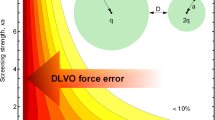Summary
Under suitable conditions it is shown that a generalized dielectric constantɛ(k, Θ) for an arbitrary many-body problem may be defined by analogy with the macroscopic laws of electrostatics. The ground state energy may then be simply expressed in terms ofɛ(k, Θ) without resort to perturbation theoretic expansions. Within the random phase approximation (RPA),ɛ(k, Θ)=1+4πα(k, Θ), where α(k, Θ) is the complex polarizability obtained by a generalized Kramers-Heisenberg formula in the plane wave representation. For the free electron gas, this value ofɛ(k, Θ) leads directly to the expression for the ground state energy obtained byGell-Mann andBrueckner and byHubbard in the high density limit. It is shown that the treatment of electron interaction within the RPA is equivalent to taking into account only the field of surface charges at the external boundary of the system; it thus corresponds to neglecting all potential and local field corrections,ɛ(k, Θ) may be inferred from the inelastic scattering of fast electrons or from the Compton scattering of X-rays; the circumstances are discussed under which such experiments yield information about the ground state energy of the electron gas.
Riassunto
Si dimostra che in condizioni opportune si può definire per analogia con le leggi macroscopiche dell’elettrostatica una costante dielettrica generalizzata ε(k, Ω) per un problema arbitrario di molti corpi. L’energia dello stato fondamentale si può allora esprimere semplicemente in termini di ε(k, Ω) senza far ricorso agli sviluppi della teoria delle perturbazioni. Nell’approssimazione della fase casuale (RPA), ε(k, Ω)=1+4πα(kΩ), dove α(kΩ) è la polarizzabilità complessa ottenuta per mezzo di una formula di Kramers-Heisenberg generalizzata nella rappresentazione delle onde piane, Per il gas di elettroni liberi questo valore di ε(k, Ω) porta direttamente all’espressione dell’energia dello stato fondamentale ottenuta daGell-Mann eBrueckner e daHubbard al limite delle densità elevate. Si dimostra che il trattamento dell’interazione elettronica nei limiti dell’RPA è equivalente a tener conto del solo campo delle cariche superficiali al limite esterno del sistema; corrisponde pertanto a trascurare tutte le correzioni di potenziale e di campo locale. Si può dedurre ε(k, Ω) dallo scattering anelastico degli elettroni veloci o dallo scattering Compton dei raggi X; si discutono le condizioni in cui tali esperimenti forniscono dati sull’energia dello stato fondamentale del gas di elettroni.
Similar content being viewed by others
References
L. Van Hove:Phys. Rev.,95, 249 (1954). Our approach is closely related to the treatment of the scattering and self energy of charged particles in a free electron gas given byLindhard:Kgl. Danske Mat.-fys. Medd.,28, 8 (1954).
D. Bohm andD. Pines:Phys. Rev.,92, 609 (1953).
K. A. Brueckner andM. Gell-Mann:Phys. Rev.,106, 364 (1957).
K. Sawada:Phys. Rev.,106, 372 (1957);K. A. Brueckner, N. Fukuda, K. Sawada andR. Brout:Phys. Rev.,108, 507 (1957).
J. Hubbard:Proc. Roy. Soc., A240, 539 (1957); A243, 336 (1958).
A preliminary report on these results has been given by the authors:Phys. Rev.,109, 1009 (1958).
J. Hubbard:Proc. Phys. Soc., A68, 441 (1955).
H. Frölich andH. Pelzer:Proc. Phys. Soc., A68, 525 (1955).
P. Nozières andD. Pines:Phys. Rev.,109, 762 (1958).
To obtain (6), we have assumed that the system was invariant by reflexion. A detailed discussion of this point is given by the authors inPhys. Rev.,109, 741 (1958).
U. Fano:Phys. Rev.,103, 1202 (1956).
Private communication fromV. Weisskopf. This relation is demonstrated in the paper ofK. Sawada (ref. (4).
See footnote (10).
H. Watanabe:Journ. Phys. Soc. Japan,11, 112 (1956). A discussion of this problem is given byD. Pines:Rev. Mod. Phys.,28, 184 (1956).
See for instance a paper by the authors:Phys. Rev.,109, 741 (1958). Thef sum rule can be easily established by calculating the quantity [[H 0,ϱk],ϱ-{k}]00, first directly, and then in the representation in terms of theΨ n .
P. Nozières andD. Pines: submitted to thePhys. Rev.
J. Goldstone:Proc. Roy. Soc., A239, 267 (1957).
N. Hugenholtz:Physica,23, 481, 533 (1957).
The authors wish to thank Prof.H. Curien, for drawing their attention to the interpretation of Compton scattering data.
N. N. Bogoljubov:Journ. Phys. USSR,11, 23 (1947).
K. Huang, T. D. Lee andC. N. Yang:Phys. Rev.,106, 1135 (1957).
Author information
Authors and Affiliations
Additional information
National Science Foundation Senior Post Doctoral Fellow on leave of absence from Princeton University, 1957–58.
Rights and permissions
About this article
Cite this article
Nozières, P., Pines, D. A dielectric formulation of the many body problem: Application to the free electron gas. Nuovo Cim 9, 470–490 (1958). https://doi.org/10.1007/BF02725103
Received:
Published:
Issue Date:
DOI: https://doi.org/10.1007/BF02725103



